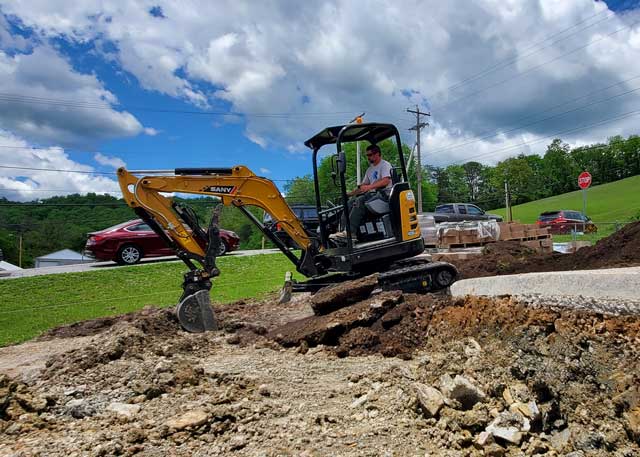Inexpensive Lancaster Excavation - High Quality Excavation at Competitive Rates
Inexpensive Lancaster Excavation - High Quality Excavation at Competitive Rates
Blog Article
Comprehensive Excavation Strategies: Grasping the Fundamentals for Success
In the realm of construction and civil design, the relevance of reliable excavation techniques can not be overstated. The mindful preparation, specific implementation, and thorough focus to detail called for in excavation tasks require a comprehensive technique that includes different essential facets. From initial dirt evaluation to the implementation of precaution and normal progression tracking, grasping these core elements is important for attaining success in any kind of excavation endeavor. Nevertheless, truth mastery lies not simply in comprehending these principles however in flawlessly integrating them to navigate the complexities of excavation jobs with finesse.
Recognizing Excavation Task Preparation

Successful excavation tasks are built on the foundation of complete and thorough planning. The initial stage of any excavation project is the drawing board, where important choices are made that can significantly impact the outcome of the job. During this phase, it is crucial to collect all appropriate information regarding the site, including topographical surveys, soil composition, and any possible risks that may exist. Comprehending the job budget, extent, and timeline constraints is crucial for creating a thorough excavation plan that guarantees the job's success.
One trick facet of excavation task planning is the development of an in-depth timeline that details the sequence of due dates, activities, and milestones. By very carefully considering all these elements throughout the planning phase, excavation projects can be performed efficiently and effectively, leading to effective end results - lancaster trenching.
Dirt Analysis and Website Assessment
Conducting detailed soil analysis and website evaluation is an essential step in the preparation phase of any kind of excavation task. Dirt analysis includes identifying the make-up, framework, and residential or commercial properties of the soil at the excavation site. This information is vital for recognizing the soil's bearing capacity, wetness web content, and possibility for disintegration, which are vital consider identifying the excavation methods and tools required for the project.
Site analysis exceeds dirt analysis and encompasses a wider analysis of the total website conditions. This assessment consists of identifying any type of prospective hazards, such as below ground utilities, ecological problems, or unstable surface, that might impact the excavation procedure. By extensively examining the site, task managers can create effective excavation methods that prioritize security, effectiveness, and environmental management.
Making use of advanced modern technologies like ground-penetrating radar, soil sampling, and drone studies can improve the accuracy and effectiveness of soil analysis and site evaluation. Spending time and resources in these initial steps can ultimately conserve time and avoid pricey hold-ups or issues throughout the excavation process.
Equipment Option and Use
Reliable excavation tasks depend greatly on tactical equipment choice and usage to make certain optimal performance and productivity. Choosing the appropriate equipment for the work is essential in making best use of performance and lessening downtime. Variables such as the sort of soil, depth of excavation, and job extent play a significant duty in determining why not try here one of the most suitable tools for the job at hand.

In enhancement to picking the appropriate equipment, appropriate usage is key to job success. Operators must be educated to handle the devices safely and successfully - excavating ohio. Normal maintenance checks and timely repairs assist avoid break downs and ensure constant efficiency throughout the project
Safety And Security Steps and Laws Compliance
In the world of excavation jobs, prioritizing precaution and compliance with policies is extremely important to ensuring a protected and lawfully sound operational atmosphere. Precaution include a series of practices, including conducting comprehensive site evaluations, executing appropriate signage and obstacles, and providing sufficient safety and security training for all workers included in the excavation process. Adherence to regulations, such as OSHA requirements in the United States, makes sure that the excavation job satisfies the required criteria to safeguard employees, spectators, and the surrounding atmosphere.

Tracking Progression and Adjusting Approaches
Exactly how can forecast supervisors successfully track the innovation of excavation projects and adapt their approaches appropriately to enhance outcomes? Tracking progress is essential for ensuring that excavation jobs remain on track and fulfill due dates. Task supervisors can make use of numerous tools and strategies to track progression, such as day-to-day report card, normal site assessments, and progressed monitoring modern technologies like drones and GPS tracking systems. By continually keeping an eye on the task's development, managers can identify any possible visit their website delays or concerns early on and take positive actions to address them.

Conclusion
To conclude, understanding the basics of extensive excavation strategies is essential for the success of any type of task. By understanding project planning, analyzing soil and site problems, choosing appropriate equipment, abiding by security laws, and checking progression, job supervisors can guarantee a smooth and reliable excavation process. Implementing these techniques will certainly bring about successful end results and decrease potential risks or setbacks throughout the excavation job.
The preliminary stage of any kind of excavation task is the preparation stage, where crucial choices are made that can considerably impact the outcome of the job. Comprehending the task spending plan, timeline, and scope restraints is crucial for creating a detailed excavation strategy that makes sure the project's success.
Exactly how can predict managers effectively track the improvement of excavation projects and adjust their methods as necessary to maximize results? By closely checking progress and being eager to adjust methods, project managers can enhance the general success of excavation tasks.
By comprehending task preparation, examining soil and site problems, picking ideal equipment, complying with safety and security policies, and keeping track of progression, project supervisors can guarantee a reliable and smooth excavation process.
Report this page